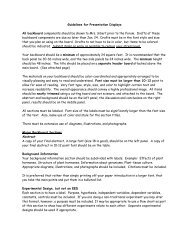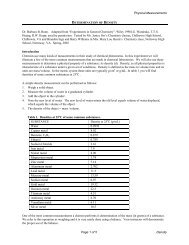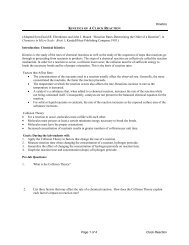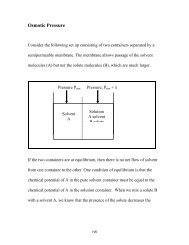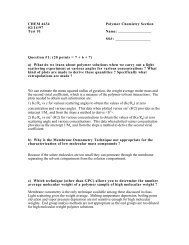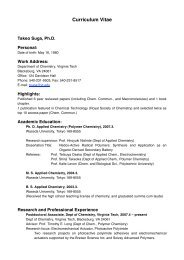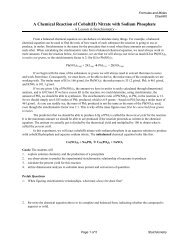Heat Transfer-1 (color)
Heat Transfer-1 (color)
Heat Transfer-1 (color)
Create successful ePaper yourself
Turn your PDF publications into a flip-book with our unique Google optimized e-Paper software.
Materials Engineering Science<br />
MESc. 5025<br />
Instructor: Herve Marand<br />
Chapter 6.<br />
<strong>Heat</strong> <strong>Transfer</strong>
• There are three modes of heat transfer:<br />
– Conduction<br />
– Convection<br />
– Radiation<br />
<strong>Heat</strong> <strong>Transfer</strong><br />
• In its simplest form, the rate of heat transfer is equal to the product<br />
of a driving force and a thermal conductance.<br />
• Thermal conductances vary for each mode of heat transfer<br />
• Conduction:<br />
Conduction is accomplished via two mechanisms:<br />
– Molecular Interactions:<br />
Molecules in high energy levels (high T) impart energy to<br />
adjacent molecules at lower energy levels.<br />
This type of heat transfer necessitates the presence of molecules<br />
of solid, liquid or gas and the existence of T gradient.
– <strong>Heat</strong> <strong>Transfer</strong> via Free Electrons:<br />
This second conduction heat transfer mechanism is observed<br />
primarily in metallic solids. The concentration of free electrons<br />
varies considerably for metallic alloys and is very low for nonmetals.<br />
The previous statement implies that the ability of solids<br />
to conduct heat via this mechanism varies directly with the free<br />
electron concentration (pure metals conduct heat the best). This<br />
conduction mechanism also relies on the existence of a<br />
temperature gradient.<br />
• Theoretical Treatment of <strong>Heat</strong> <strong>Transfer</strong> by Conduction<br />
A quantitative expression relating the rate of heat transfer, the<br />
temperature gradient and the nature of the conducting medium<br />
is attributed to Fourier (1822)<br />
q x dT<br />
= − k temperature<br />
A dx gradient along x<br />
<strong>Heat</strong> flux= heat thermal<br />
flow rate per unit conductivity<br />
area in direction x of material<br />
A: area normal to<br />
heat flow
• Units:<br />
quantity S.I. unit non-S.I. unit<br />
q Watt or J.s-1 Btu/hr<br />
A m 2 ft 2<br />
dT/dx K.m -1 °F.ft -1<br />
k W. K -1 .m -1 Btu.hr -1 .ft -1 .°F -1<br />
• Unit Conversion Factor:<br />
1 Watt = 1 J.s -1 = 3.414 Btu.hr -1<br />
1 Btu = 1054 Joules<br />
• For isotropic materials and steady state conditions, the<br />
Fourier equation can be generalized as:<br />
q<br />
A<br />
= − k∇ T<br />
k = k e + k i<br />
- sign accounts for heat<br />
transfer from hot to cold<br />
molecular interactions<br />
free electrons<br />
⎛<br />
⎜<br />
⎜<br />
∇ = ⎜<br />
⎜<br />
⎜<br />
⎝<br />
⎞<br />
⎟<br />
x<br />
⎟<br />
⎟<br />
y⎟<br />
⎟<br />
z ⎠<br />
is the<br />
gradient<br />
vector
• In most solids, the principal mode of thermal energy<br />
assimilation is by increase in vibrational energy of the<br />
atoms. Atoms in solids are constantly vibrating at very<br />
high frequencies and with relatively small amplitudes. The<br />
atomicvibrations of adjacent atoms are coupled through the<br />
atomic bonding. These vibrations are coordinated in such<br />
a way that traveling lattice waves are produced. (These<br />
may be thought of as elastic waves or simply sound waves<br />
(short wavelength and high frequency), which propagate<br />
through a crystal at the velocity of sound. The vibrational<br />
thermal energy for an ordered material consist of a series<br />
of elastic waves (with a distribution of frequencies). Only<br />
certain energies are allowed (quantization of the<br />
vibrational energy). A single quantum of vibrational<br />
energy is called a phonon. Note that phonon waves can<br />
scatter free electrons during electronic conduction, thus<br />
they control the temperature dependence of electronic<br />
conduction
• In metals, the free electron mechanism of heat transport is<br />
much more efficient than the phonon mechanism, because<br />
phonons are more easily scattered than free electrons and<br />
electrons ahave higher velocities.<br />
• Thermal energy associated with phonons is transported in<br />
the direction of their motion (net movement of phonons<br />
from high to low temperature regions)<br />
• Free electrons in hot regions have higher kinetic energy<br />
tham these in cold regions. When they migrate to colder<br />
regions, their kinetic energy is transferred to atoms as<br />
vibrational energy (collision of electrons with phonons).<br />
• Thermal conductivities of common pure metals or alloys<br />
range from 20 to ca. 400 W.m -1 .K -1 . When impurities are<br />
are present in a metal or alloying is used, the impurity<br />
atoms act as scattering centers for the electrons, decreasing<br />
the efficiency of electron motion (i.e. k e)
• In ceramics k e
• Polymers:<br />
Thermal conductivity for most polymers is of the order of<br />
0.3 W.m -1 .K -1 . Energy transfer is accomplished by the<br />
vibrations and rotations of chain backbone and side chain<br />
bonds.<br />
The magnitude of the thermal conductivity increases with<br />
the degree of crystallinity.<br />
Polymers are used as low temperature thermal insulators<br />
(porous polymershave enhanced insulative properties).<br />
• Gases:<br />
Thermal conductivity is low but increases with<br />
temperature due to increased Brownian motion resulting in<br />
a higher frequency of contact and increase in molecular<br />
exchange rates. For dilute gases (low pressure, P
Kinetic Theory of Gases:<br />
assumes ideal gas behavior.<br />
Chapman-Erskog Theory:<br />
accounts for pairwise interactions<br />
based on the Lennard-Jones potential.<br />
T: absolute temperature<br />
m: molecular mass<br />
M: molar mass<br />
d: molecular diameter<br />
k b: Boltzmann constant<br />
Ω k, σ: related to Lennard-Jones potential<br />
k =<br />
k =<br />
1<br />
3 / 2 d 2<br />
1.9891 ⋅10 −4<br />
Ω k 2<br />
k<br />
3<br />
T<br />
b<br />
m<br />
T<br />
M<br />
see viscosity<br />
section for<br />
discussion on Ω k<br />
Chapman-Erskog theory accounts better than the Kinetic<br />
Theory for the temperature dependence of interactions.
Anisotropicity of the Thermal Conductivity<br />
• In general, in crystalline materials, the simplified Fourier<br />
equation is not rigorously valid asthe thermal conductivity<br />
may be different in different directions in the crystal.<br />
• The scalar k must be replaced by the tensor k (3x3). The<br />
Tensor is symmetrical (Onsager’s principle)<br />
˜<br />
k =<br />
˜<br />
k =<br />
⎛<br />
⎜<br />
⎜<br />
⎝<br />
k11 k21 k31<br />
k12 k22 k32<br />
k13 k23 k33<br />
⎛ k1 0 0 ⎞<br />
⎜ ⎟<br />
0 k2 0<br />
⎜<br />
⎟<br />
⎝ 0 0 k3⎠<br />
⎞<br />
⎟<br />
⎟<br />
⎠<br />
where: -k ij = rate of heat transfer per<br />
unit cross section parallel to the axis<br />
defined by “i” from a temperature<br />
gradient along the “j”-axis<br />
if the crystal axes are matching the<br />
laboratory axes<br />
Note: that q and ∇ T<br />
will generally not be parallel unless the crystal<br />
is cubic (i.e. k1=k2=k3)
Example Calculation #1<br />
• Steam is transported through a 11/2 “ mild steel pipe. The inside<br />
and outside pipe wall temperatures are 205°F and 195°F,<br />
respectively. OD = 1.9” ; ID = 1.5”; k = 24.8 Btu.hr -1 .ft -1 .°F -1<br />
– 1) Find the heat loss for 10 feet of pipe<br />
– 2) FInd the heat flux based upon inside and outside surface<br />
areas.<br />
• <strong>Heat</strong> is transferred radially. The applicable scalar form of the<br />
Fourier rate equation is:<br />
qr = −kA<br />
For the steady state case, qr is constant<br />
dT ⎫<br />
dr ⎬<br />
A = 2 rL<br />
⎪<br />
⇒ qr = −k( 2 rL)<br />
⎪ ⎭<br />
dT<br />
dr<br />
rodr<br />
To<br />
qr ∫ = −2 kL ∫ dT ⇒ qr ln<br />
r<br />
ro ⎛ ⎞<br />
⎜ ⎟ = −2 kL( To − Ti )<br />
⎝ ⎠<br />
r i<br />
T i<br />
r i
( )<br />
qr = 2 kL Ti − To ln r ⎛ o ⎞<br />
⎜ ⎟<br />
⎝ ⎠<br />
q r<br />
A i<br />
qr<br />
A o<br />
=<br />
=<br />
r i<br />
65, 000<br />
⋅ 1.5 ⎛ ⎞<br />
⎜ ⎟ ⋅10<br />
⎝ 12 ⎠<br />
65, 000<br />
⋅ 1.9 ⎛ ⎞<br />
⎜ ⎟ ⋅10<br />
⎝ 12 ⎠<br />
= 2 ⋅ 3.14 ⋅ 24.8 ⋅ 10 ⋅10<br />
ln 1.9 ⎛ ⎞<br />
⎜ ⎟<br />
⎝ 1.5 ⎠<br />
The heat flux is q/A (rate of heat loss per unit area)<br />
= 16, 700 Btu/hr.ft 2<br />
= 13,150 Btu/hr.ft 2<br />
= 65, 000 Btu/hr
Example Calculation #2<br />
• For steady state heat conduction through a wall with<br />
dimensions and surface temperatures shown below, express:<br />
T 0<br />
x=0<br />
– 1) the heat flow rate for a constant thermal conductivity k.<br />
– 2) the heat flow rate, when the thermal conductivity of the<br />
wall material varies linearly with temperature k = k 0(1+βT).<br />
x<br />
x=L<br />
T L<br />
• 1)<br />
• 2)<br />
q x dx = −kAdT<br />
L<br />
q x ∫ dx = −kA ∫ dT<br />
0<br />
T L<br />
T 0<br />
( )<br />
q x L = −kA T L − T 0<br />
q x = kA<br />
L T ( L − T0) q x = −k0 ( 1 + T)A<br />
dT<br />
dx<br />
q x = k0 A<br />
L 1 + 2 T0<br />
⎡<br />
⎢ + TL<br />
⎣<br />
( )<br />
⎤<br />
⎥ ⎦<br />
TL − T0<br />
[ ]
Convection<br />
• Convection <strong>Heat</strong> <strong>Transfer</strong>: involves the exchange of heat<br />
between a fluid and a surface or an interface.<br />
• Two kinds of convection exist:<br />
– Forced convection in which fluid motion past a surface<br />
is caused by an external agency<br />
– Free convection in which density changes in the fluid<br />
which result from energy exchange lead to a natural<br />
(i.e.unassisted) fluid motion.<br />
• Newton (1701) first expressed the basic rate equation for<br />
convective heat transfer (Newton’s law of cooling).<br />
rate of convective<br />
heat transfer (Btu/hr)<br />
q = hA( Tsurf − T ) fluid temperature<br />
driving force<br />
convective heat<br />
transfer coefficient<br />
(Btu.hr -1 .ft -2 .°F -1 )<br />
area normal to the<br />
direction of heat flow
• Regardless of the flow phenomenon involved, it is known that<br />
directly adjacent to the interface, the energy transfer mechanism is<br />
that of conduction. The surface conductive layers of fluid control<br />
the heat transfer rate and determine the value of “h”, which is<br />
justifiably often called the “film coefficient”. The only difficulty in<br />
describing convective phenomena lies in the evaluation of “h”.<br />
• If we write : q = KΔT where K is the thermal conductance.<br />
K convection = hA<br />
K conduction hollow cylinder =<br />
K conduction plane wall = kA<br />
L<br />
2 kL<br />
ln r ⎫<br />
⎪<br />
⎪<br />
⎪<br />
⎪<br />
⎬ Btu / hr.°F<br />
⎛ o ⎞ ⎪<br />
⎜ ⎟<br />
⎝ ri ⎠ ⎪<br />
⎪<br />
⎪<br />
⎭ ⎪
• Range of values for “h” allows the convective mechanism<br />
to be understood<br />
– mechanism h (Btu.hr -1 .ft -2 .°F -1 )<br />
condensing water vapor 1,000 to 20,000<br />
boiling water 500 to 5,000<br />
forced convection (H 2O) 50 to 3,000<br />
forced convection (air) 5 to 100<br />
free convection 1 to 10
Example Calculations #3<br />
Given the steel pipe with conditions described in Example #1, with<br />
10°F air surrounding the pipe and 210°F steam flowing on the<br />
inside, evaluate the convective heat transfer coefficients on each of<br />
the pipe surfaces and indicate the operating mechanisms.<br />
1) q r/A i = 16,700 Btu.hr -1 .ft -2<br />
T steam - T surface = 210 -205°F<br />
h = 16,700 / 5 = 3,340 Btu.hr -1 .ft -2 .°F -1<br />
Steam is condensing on the inside of the pipe<br />
2) q r/A o = 13,150 Btu.hr -1 .ft -2<br />
T surface - T air = 195 -10°F<br />
h = 13,150 / 185 = 71 Btu.hr -1 .ft -2 .°F -1<br />
Air must be in forced convection
Thermal Radiation<br />
• <strong>Heat</strong> transfer by radiation requires no medium for<br />
propagation. Radiant exchange between surfaces is in fact<br />
maximum when no material occupies the intervening<br />
space. This type of energy transfer by radiation is an<br />
electromagnetic phenomenon and the exact nature still not<br />
completely understood.<br />
• A perfectly emitting or absorbing body is called a black<br />
body. The rate at which it emits radiant energy is given by<br />
the Stephan-Boltzmann law of Thermal radiation:<br />
radiant emission in Btu/hr<br />
q<br />
A<br />
= T 4<br />
Absolute<br />
Temperature<br />
area of emitting surface in ft 2 Stephan-Boltzmann constant



